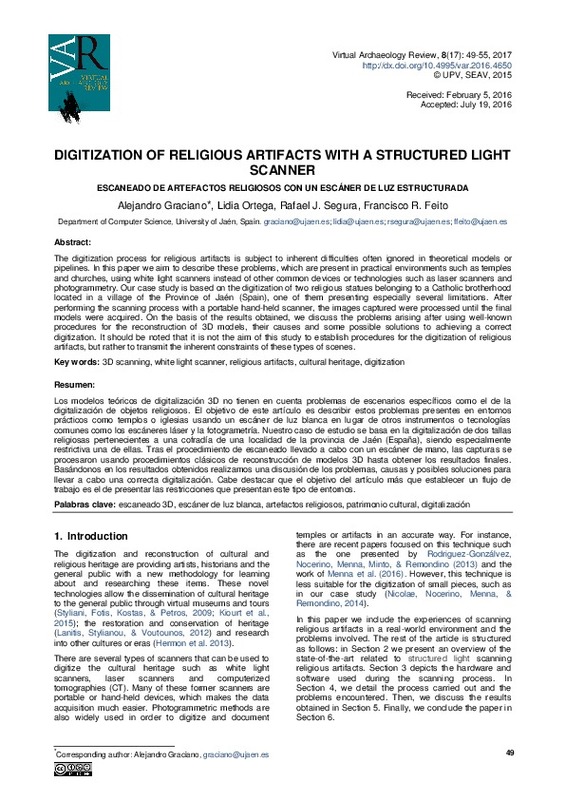JavaScript is disabled for your browser. Some features of this site may not work without it.
Buscar en RiuNet
Listar
Mi cuenta
Estadísticas
Ayuda RiuNet
Admin. UPV
Digitization of religious artifacts with a structured light scanner
Mostrar el registro sencillo del ítem
Ficheros en el ítem
| dc.contributor.author | Graciano, Alejandro
|
es_ES |
| dc.contributor.author | Ortega, Lidia
|
es_ES |
| dc.contributor.author | Segura, Rafael J.
|
es_ES |
| dc.contributor.author | Feito, Francisco R.
|
es_ES |
| dc.date.accessioned | 2017-10-27T07:12:32Z | |
| dc.date.available | 2017-10-27T07:12:32Z | |
| dc.date.issued | 2017-07-26 | |
| dc.identifier.uri | http://hdl.handle.net/10251/90131 | |
| dc.description.abstract | [EN] The digitization process for religious artifacts is subject to inherent difficulties often ignored in theoretical models or pipelines. In this paper we aim to describe these problems, which are present in practical environments such as temples and churches, using white light scanners instead of other common devices or technologies such as laser scanners and photogrammetry. Our case study is based on the digitization of two religious statues belonging to a Catholic brotherhood located in a village of the Province of Jaén (Spain), one of them presenting especially several limitations. After performing the scanning process with a portable hand-held scanner, the images captured were processed until the final models were acquired. On the basis of the results obtained, we discuss the problems arising after using well-known procedures for the reconstruction of 3D models, their causes and some possible solutions to achieving a correct digitization. It should be noted that it is not the aim of this study to establish procedures for the digitization of religious artifacts, but rather to transmit the inherent constraints of these types of scenes. | es_ES |
| dc.description.abstract | [ES] Los modelos teóricos de digitalización 3D no tienen en cuenta problemas de escenarios específicos como el de la digitalización de objetos religiosos. El objetivo de este artículo es describir estos problemas presentes en entornos prácticos como templos o iglesias usando un escáner de luz blanca en lugar de otros instrumentos o tecnologías comunes como los escáneres láser y la fotogrametría. Nuestro caso de estudio se basa en la digitalización de dos tallas religiosas pertenecientes a una cofradía de una localidad de la provincia de Jaén (España), siendo especialmente restrictiva una de ellas. Tras el procedimiento de escaneado llevado a cabo con un escáner de mano, las capturas se procesaron usando procedimientos clásicos de reconstrucción de modelos 3D hasta obtener los resultados finales. Basándonos en los resultados obtenidos realizamos una discusión de los problemas, causas y posibles soluciones para llevar a cabo una correcta digitalización. Cabe destacar que el objetivo del artículo más que establecer un flujo de trabajo es el de presentar las restricciones que presentan este tipo de entornos. | es_ES |
| dc.description.sponsorship | This study has been partially supported by the Ministerio de Ciencia e Innovación and the European Union (via ERDF funds) under the research project TIN2014-58218-R, and by the University of Jaén through the research project UJA2015/08/10 | |
| dc.language | Inglés | es_ES |
| dc.publisher | Universitat Politècnica de València | |
| dc.relation.ispartof | Virtual Archaeology Review | |
| dc.rights | Reconocimiento - No comercial - Sin obra derivada (by-nc-nd) | es_ES |
| dc.subject | 3D scanning | es_ES |
| dc.subject | White light scanner | es_ES |
| dc.subject | Religious artifacts | es_ES |
| dc.subject | Cultural heritage | es_ES |
| dc.subject | Digitization | es_ES |
| dc.subject | Escaneado 3D | es_ES |
| dc.subject | Escáner de luz blanca | es_ES |
| dc.subject | Artefactos religiosos | es_ES |
| dc.subject | Patrimonio cultural | es_ES |
| dc.subject | Digitalización | es_ES |
| dc.title | Digitization of religious artifacts with a structured light scanner | es_ES |
| dc.title.alternative | Escaneado de artefactos religiosos con un escáner de luz estructurada | es_ES |
| dc.type | Artículo | es_ES |
| dc.date.updated | 2017-10-27T06:31:23Z | |
| dc.identifier.doi | 10.4995/var.2016.4650 | |
| dc.relation.projectID | info:eu-repo/grantAgreement/MINECO//TIN2014-58218-R/ES/APORTACIONES PARA LAS CIUDADES INTELIGENTES. HACIA UN SIG 3D DEL SUBSUELO/ | es_ES |
| dc.relation.projectID | info:eu-repo/grantAgreement/UJA//2015%2F08%2F10/ | es_ES |
| dc.rights.accessRights | Abierto | es_ES |
| dc.description.bibliographicCitation | Graciano, A.; Ortega, L.; Segura, RJ.; Feito, FR. (2017). Digitization of religious artifacts with a structured light scanner. Virtual Archaeology Review. 8(17):49-55. https://doi.org/10.4995/var.2016.4650 | es_ES |
| dc.description.accrualMethod | SWORD | es_ES |
| dc.relation.publisherversion | https://doi.org/10.4995/var.2016.4650 | es_ES |
| dc.description.upvformatpinicio | 49 | es_ES |
| dc.description.upvformatpfin | 55 | es_ES |
| dc.type.version | info:eu-repo/semantics/publishedVersion | es_ES |
| dc.description.volume | 8 | |
| dc.description.issue | 17 | |
| dc.identifier.eissn | 1989-9947 | |
| dc.contributor.funder | Ministerio de Ciencia e Innovación | |
| dc.contributor.funder | Universidad de Jaén | |
| dc.description.references | Wang, K., Lavoué, G., Denis, F., & Baskurt, A. (2011). Robust and blind mesh watermarking based on volume moments. Computers & Graphics, 35(1), 1-19. doi:10.1016/j.cag.2010.09.010 | es_ES |








